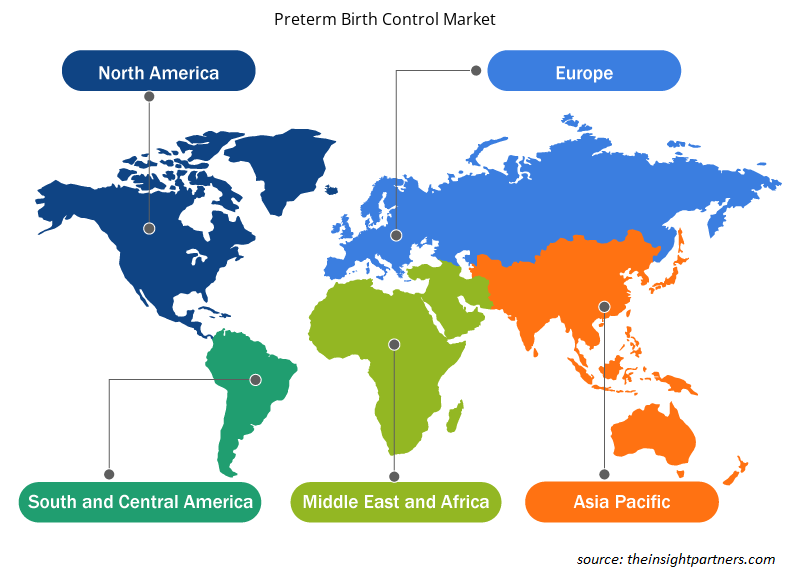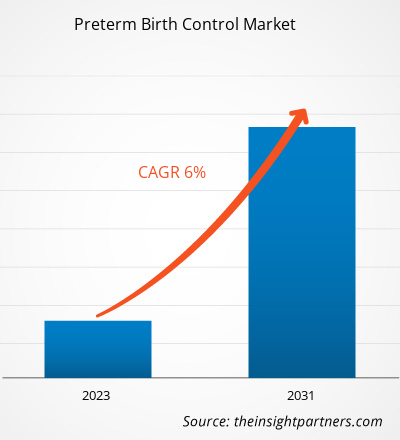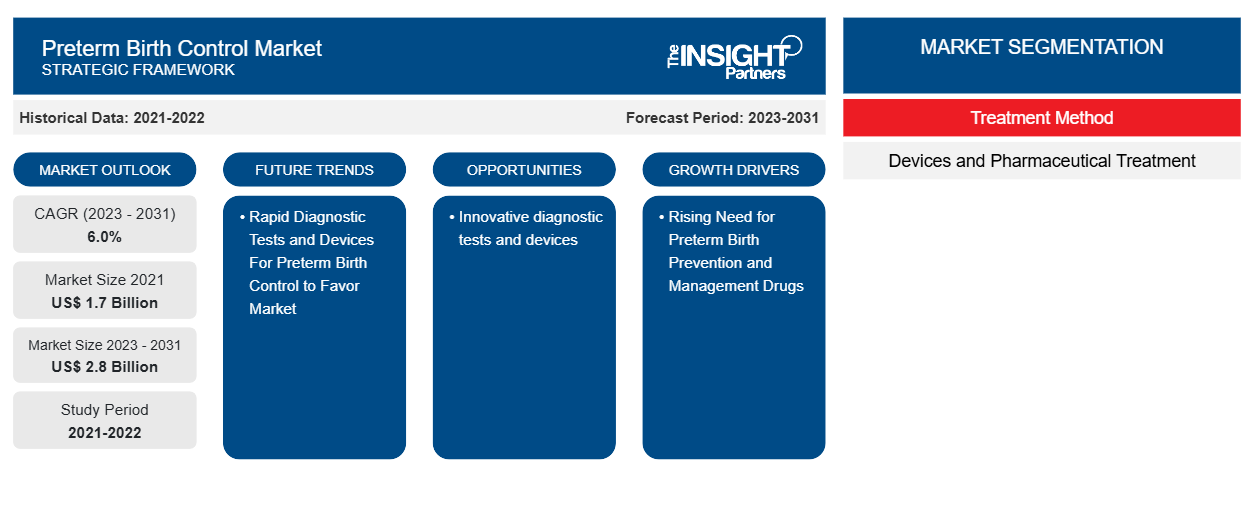Le marché du contrôle des naissances prématurées était évalué à 1,7 milliard de dollars américains en 2021 et devrait atteindre 2,8 milliards de dollars américains d'ici 2031. Le marché devrait enregistrer un TCAC de 6,0 % entre 2023 et 2031. L'introduction de nouveaux tests et dispositifs de diagnostic devrait rester l'une des principales tendances du marché du contrôle des naissances prématurées.ControlMarket was valued at US$ 1.7 billion in 2021 and is expected to reach US$ 2.8 billion by 2031. The market is expected to register a CAGR of 6.0% from 2023–2031. Introduction of novel diagnostic tests and devices is likely to remain key Preterm Birth Control Market trends.
Analyse du marché des contraceptifs pour les naissances prématuréesControlMarket Analysis
Besoin croissant de médicaments pour la prévention et la gestion des naissances prématurées
L'accouchement prématuré se produit lorsqu'un bébé naît trop tôt, avant 37 semaines de grossesse. De plus, les bébés nés trop tôt (avant 32 semaines) ont des taux de mortalité et d'invalidité plus élevés. Selon le rapport des Centers for Disease Control and Prevention (CDC), en 2022, l'accouchement prématuré a touché près d'un nourrisson sur 10 né aux États-Unis. Par conséquent, il existe un besoin croissant de gérer l'accouchement prématuré. Par exemple, les recommandations comprennent un traitement à la progestérone pour les femmes présentant un risque d'accouchement prématuré, des médicaments thérapeutiques et des méthodes de diagnostic. Les médicaments les plus courants pour le travail prématuré sont les « corticostéroïdes anténatals (également appelés ACS) ». Les ACS comprennent des médicaments tels que la bétaméthasone et la dexaméthasone. De plus, le travail prématuré peut être évité par des antibiotiques. Les antibiotiques comprennent la « céftriaxone », la « clarithromycine » et le « métronidazole ». Par conséquent, grâce à des thérapies innovantes, des dispositifs médicaux et des méthodes de dépistage, les naissances prématurées peuvent être gérées efficacement, stimulant ainsi la croissance du marché au cours de la période 2021-2031.corticosteroids (also called ACS)." The ACS includes medicines such as betamethasone and dexamethasone. Additionally, preterm labor can be prevented by antibiotics. Antibiotics include "Ceftriaxone," "Clarithromycin," and "Metronidazole." Therefore, through innovative therapeutics, medical devices, and screening methods preterm birth can be effectively managed thereby driving the market growth during 2021-2031.
Aperçu du marché de la contraception prématuréeControlMarket Overview
La technologie, l’innovation et les solutions technologiques intelligentes continuent d’influencer considérablement le marché du contrôle des naissances prématurées. Le besoin croissant de médicaments pour la prévention et la gestion des naissances prématurées et de tests et dispositifs de diagnostic rapide sont les facteurs les plus influents responsables de la croissance du marché du contrôle des naissances prématurées. Les tests et dispositifs de diagnostic innovants sont une tendance clé pour la croissance du marché du contrôle des naissances prématurées. Les innovations en matière de produits de contrôle des naissances prématurées offriront des opportunités de marché lucratives pour la croissance du marché du contrôle des naissances prématurées.devicesare the most influential factors responsible for Preterm Birth Control Market growth. Innovative diagnostic tests and devices is a key trend for Preterm Birth Control Market growth. Preterm birth control product innovationswill provide lucrative market opportunity for the Preterm Birth Control Market growth.
Personnalisez ce rapport en fonction de vos besoins
Vous bénéficierez d'une personnalisation gratuite de n'importe quel rapport, y compris de certaines parties de ce rapport, d'une analyse au niveau des pays, d'un pack de données Excel, ainsi que de superbes offres et réductions pour les start-ups et les universités.
-
Obtenez les principales tendances clés du marché de ce rapport.Cet échantillon GRATUIT comprendra une analyse de données, allant des tendances du marché aux estimations et prévisions.
Contrôle des naissances prématuréesMoteurs et opportunités du marchéControlMarket Drivers and Opportunities
Les tests et dispositifs de diagnostic rapide pour le contrôle des naissances prématurées devraient favoriser le marché
Les naissances prématurées sont l'une des principales causes de mortalité infantile, les nouveau-nés étant souvent confrontés à des problèmes à vie tels que des problèmes respiratoires, une paralysie cérébrale et des déficiences intellectuelles. En outre, le travail prématuré représente d'énormes coûts de santé. Par exemple, en Europe, le coût des soins de santé associé à la contraception prématurée s'élève à 21,3 milliards de dollars américains et à 23 milliards de dollars américains aux États-Unis. Par conséquent, le développement de dispositifs médicaux et de tests de diagnostic innovants peut surmonter les défis et les coûts de santé associés au travail prématuré. Par exemple, le « Pregnolia System Device » fabriqué par Pregnolia est un nouvel appareil de diagnostic qui peut déterminer le risque de naissance prématurée en détectant la rigidité du tissu cervical. L'appareil est sûr, facile à utiliser et plus efficace pour prédire le risque que les appareils à ultrasons actuels. De plus, le « PreTRM Test » de PreTRM est le premier test prédictif qui identifie le risque d'accouchement prématuré spontané d'une femme enceinte pour améliorer les résultats même en l'absence de facteurs de risque évidents. Le test PreTRM est le seul test sanguin cliniquement validé et disponible dans le commerce qui fournit une évaluation précoce et individualisée du risque d'accouchement prématuré spontané dans les grossesses uniques asymptomatiques.Pregnolia System Device" manufactured by Pregnolia is a novel diagnostic device that can determine the risk of premature birth by detecting cervical tissue stiffness. The device is safe, user-friendly, and more efficient in predicting risk than current ultrasound technology devices. Additionally, PreTRM's "PreTRM Test" is the first predictive test that identifies a pregnant woman's risk of spontaneous preterm birth to improve outcomes even if they lack evident risk factors. The PreTRM Test is the only clinically validated and commercially available blood test that provides early, individualized risk assessment for spontaneous preterm birth in asymptomatic, singleton pregnancies.
Innovations en matière de produits de contraception pour les prématurés : une opportunité
La prestation de soins de santé se développe rapidement et les fabricants ont déployé des efforts considérables dans le passé pour accélérer la vitesse et la précision des tests de diagnostic dans les établissements de santé pour les naissances prématurées. En juillet 2021, Organon et ObsEva ont annoncé une collaboration pour développer et commercialiser « Ebopiprant (OBE022) », un agent expérimental destiné à évaluer le premier traitement de sa catégorie pour le travail prématuré. L'Ebopiprant est un agoniste sélectif du récepteur de la prostaglandine F2α (PGF2α) actif par voie orale, expérimental et évalué comme traitement potentiel du travail prématuré, réduisant l'inflammation et les contractions utérines. Par conséquent, l'innovation de produits innovants offrira des opportunités de marché lucratives et représentera une part de marché considérable dans les années à venir pour le marché du contrôle des naissances prématurées.Organon and ObsEva announced a collaboration to develop and commercialize "Ebopiprant (OBE022)", an Investigational Agent to evaluate first-in-class treatment for preterm labor. The Ebopiprant is an investigational, orally active, selective prostaglandin F2α (PGF2α) receptor agonist evaluated as a potential treatment for preterm labor, reducing the inflammation and uterine contractions. Therefore, innovative product innovation will provide lucrative market opportunities will account considerable market share in the coming years for preterm birth control market.
Contrôle des naissances prématurées
Analyse de segmentation du rapport de marché
Les segments clés qui ont contribué à l’élaboration de l’analyse du marché du contrôle des naissances prématurées sont la candidature et les services.
- En fonction de la méthode de traitement, le marché du contrôle des naissances prématurées est divisé en dispositifs et en traitement pharmaceutique. Le segment du traitement pharmaceutique pourrait détenir une part de marché plus importante en 2023.
Analyse des parts de marché des contraceptifs prématurés par zone géographique
La portée géographique du rapport sur le marché du contrôle des naissances prématurées est principalement divisée en cinq régions : Amérique du Nord, Asie-Pacifique, Europe, Moyen-Orient et Afrique, et Amérique du Sud/Amérique du Sud et centrale.
L'Amérique du Nord a dominé le marché du contrôle des naissances prématurées. En Amérique du Nord, les États-Unis représentent une part considérable du contrôle des naissances prématurées. La présence des principales sociétés de dispositifs médicaux aux États-Unis, les interventions thérapeutiques et les développements stratégiques inorganiques des fabricants sont les facteurs les plus influents responsables de la croissance du marché. L'Asie-Pacifique devrait connaître le TCAC le plus élevé dans les années à venir.
Contrôle des naissances prématurées
Aperçu régional du marché de la contraception prématurée
Les tendances régionales et les facteurs influençant le marché du contrôle des naissances prématurées tout au long de la période de prévision ont été expliqués en détail par les analystes d’Insight Partners. Cette section traite également des segments et de la géographie du marché du contrôle des naissances prématurées en Amérique du Nord, en Europe, en Asie-Pacifique, au Moyen-Orient et en Afrique, ainsi qu’en Amérique du Sud et en Amérique centrale.

- Obtenez les données régionales spécifiques au marché du contrôle des naissances prématurées
Portée du rapport sur le marché du contrôle des naissances prématurées
| Attribut de rapport | Détails |
|---|---|
| Taille du marché en 2021 | 1,7 milliard de dollars américains |
| Taille du marché d'ici 2031 | 2,8 milliards de dollars américains |
| Taux de croissance annuel composé mondial (2023-2031) | 6,0% |
| Données historiques | 2021-2022 |
| Période de prévision | 2023-2031 |
| Segments couverts |
Par méthode de traitement
|
| Régions et pays couverts |
Amérique du Nord
|
| Leaders du marché et profils d'entreprises clés |
|
Densité des acteurs du marché de la contraception prématurée : comprendre son impact sur la dynamique commerciale
Le marché du contrôle des naissances prématurées connaît une croissance rapide, tirée par la demande croissante des utilisateurs finaux en raison de facteurs tels que l'évolution des préférences des consommateurs, les avancées technologiques et une plus grande sensibilisation aux avantages du produit. À mesure que la demande augmente, les entreprises élargissent leurs offres, innovent pour répondre aux besoins des consommateurs et capitalisent sur les tendances émergentes, ce qui alimente davantage la croissance du marché.
La densité des acteurs du marché fait référence à la répartition des entreprises ou des sociétés opérant sur un marché ou un secteur particulier. Elle indique le nombre de concurrents (acteurs du marché) présents sur un marché donné par rapport à sa taille ou à sa valeur marchande totale.
Les principales entreprises opérant sur le marché du contrôle des naissances prématurées sont :
- Cooper Chirurgie
- Produits Medgyn
- Société Integra Lifesciences
- Panpac Medical Corp.
- Ar. Arabin GmbH & Co. KG
- Amag Pharmaceutique
Avis de non-responsabilité : les sociétés répertoriées ci-dessus ne sont pas classées dans un ordre particulier.

- Obtenez un aperçu des principaux acteurs du marché du contrôle des naissances prématurées
Nouvelles du marché et développements récents sur la contraception prématurée
Le marché de la contraception prématurée est évalué en collectant des données qualitatives et quantitatives après des recherches primaires et secondaires, qui comprennent des publications d'entreprise importantes, des données d'association et des bases de données. Voici une liste des développements sur le marché de la contraception prématurée et des stratégies :
- En décembre 2023, Sera Prognostics Inc. a annoncé la création du « Data Safety Monitoring Board (DSMB) » pour l'étude pivot sur la détection de l'évaluation des risques prématurés combinée à des interventions cliniques pour améliorer les résultats néonatals (PRIME). L'étude PRIME progressera et s'améliorera pour sauver des vies et améliorer la santé globale des mères et des nouveau-nés dans le monde entier.
Rapport sur le marché de la contraception prématurée - Couverture et livrables
Le rapport « Taille et prévisions du marché du contrôle des naissances prématurées (2021-2031) » fournit une analyse détaillée du marché couvrant les domaines ci-dessous :
- Taille du marché et prévisions aux niveaux mondial, régional et national pour tous les segments de marché clés couverts par le périmètre
- Dynamique du marché, comme les facteurs moteurs, les contraintes et les opportunités clés
- Principales tendances futures
- Analyse détaillée des cinq forces de PEST/Porter et SWOT
- Analyse du marché mondial et régional couvrant les principales tendances du marché, les principaux acteurs, les réglementations et les développements récents du marché
- Analyse du paysage industriel et de la concurrence couvrant la concentration du marché, l'analyse de la carte thermique, les principaux acteurs et les développements récents
- Profils d'entreprise détaillés
- Analyse historique (2 ans), année de base, prévision (7 ans) avec TCAC
- Analyse PEST et SWOT
- Taille du marché Valeur / Volume - Mondial, Régional, Pays
- Industrie et paysage concurrentiel
- Ensemble de données Excel
Rapports récents
Témoignages
Raison d'acheter
- Prise de décision éclairée
- Compréhension de la dynamique du marché
- Analyse concurrentielle
- Connaissances clients
- Prévisions de marché
- Atténuation des risques
- Planification stratégique
- Justification des investissements
- Identification des marchés émergents
- Amélioration des stratégies marketing
- Amélioration de l'efficacité opérationnelle
- Alignement sur les tendances réglementaires























 Obtenez un échantillon gratuit pour - Marché des contraceptifs pour les naissances prématurées
Obtenez un échantillon gratuit pour - Marché des contraceptifs pour les naissances prématurées